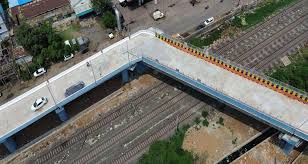Bhopal’s 90-degree bridge: CM promises action against those responsible for ‘technical faults’

Bhopal, the capital of Madhya Pradesh, recently entered national headlines—but not for a policy win or cultural event. Instead, a newly constructed overbridge in Aishbagh became the talk of the town for all the wrong reasons. This ₹18-crore project shocked the public with a bizarre 90-degree turn, sparking concerns over safety, planning, and engineering judgment.
The Sharp Bend That Raised Eyebrows
The bridge, meant to ease traffic near the Aishbagh railway crossing, delivered the opposite effect. Commuters were stunned to find a near-right-angle turn midway through the overpass. Drivers and residents alike questioned how such a design made it past approval stages.
Concerns grew rapidly. Without any warning curves or buffer space, the sharp bend poses a serious risk of collisions and rollovers—especially at night or in poor weather. As photos of the bend went viral, public outrage followed.
CM Mohan Yadav Promises Swift Action
Responding to mounting criticism, Chief Minister Mohan Yadav took quick action. He assured citizens that the bridge would not open until corrections are completed. Moreover, he promised strict accountability for those involved in what he termed “technical faults.”
Speaking to the media, Yadav emphasized the importance of safety over speed. “No structure that endangers lives will be opened. Responsible parties will face consequences,” he stated.
How Did It Get Approved?
The unusual turn is not a random error—it appears to be the result of poor coordination between departments. The project involved both the Public Works Department (PWD) and the Indian Railways. Due to land constraints near metro pillars and tracks, engineers redesigned the original smooth curve into a harsh turn to avoid acquiring additional space.
Although the initial blueprint featured a gentler turn, later changes by the Railways altered the layout significantly. Unfortunately, these adjustments created the sharp, angular path that now stands at the center of this controversy.
Experts Sound the Alarm
Several road safety specialists have strongly criticized the design. According to them, the 90-degree angle violates basic traffic engineering norms. Without lead-in curves, appropriate signage, or speed-calming measures, the risk of vehicle accidents increases sharply.
A Bhopal-based civil engineer commented, “This isn’t just a design flaw—it’s a dangerous oversight. Drivers may not have enough time to adjust or react.”
Meanwhile, social media amplified the issue. Locals shared memes and dubbed the turn “The Bhopal Hairpin,” highlighting the absurdity of such a design in an urban setting.
Government Orders Redesign
To correct the issue, the Madhya Pradesh government has formed a technical committee. This group includes engineers from both the Railways and PWD, tasked with evaluating the design and offering practical solutions. The team is also investigating why early warning signs and internal objections were ignored.
Among the redesign options being considered:
- Introducing lead-in curves to replace the sharp turn
- Widening the approach to allow smoother navigation
- Installing speed breakers, rumble strips, and reflective signage
- Exploring land acquisition to realign the entire section
Until these changes are made, the bridge will remain closed to traffic.
Political and Public Reactions
The issue has sparked fierce political debate. Opposition leaders are demanding a broader audit of recent infrastructure projects. They argue that this bridge is not an isolated failure but a symptom of weak oversight and rushed execution.
Residents have also voiced strong disapproval. Many believe that the project reflects a larger problem—one where planners fail to account for everyday usability and safety.
One local commuter remarked, “This turn is not just sharp—it’s symbolic. It shows how little thought sometimes goes into the projects meant to help us.”
A Wake-Up Call for Urban Infrastructure
The controversy highlights a larger issue in Indian urban development: poor inter-departmental coordination and limited planning foresight. As cities grow, their infrastructure needs become more complex. Hasty decisions and quick fixes can lead to bigger, more dangerous problems.
Therefore, experts suggest that cities like Bhopal must adopt better standards. These include using multi-stage design reviews, public consultations, and real-time simulations to test usability before construction begins.
Above all, accountability must be a constant part of the planning process—not just an afterthought.
What Lies Ahead?
The technical committee will submit its findings soon. Correction work has already started on parts of the bridge. Meanwhile, CM Yadav’s strong stance signals a move toward better checks and balances.
The redesign may delay the project, but public sentiment favors a careful, safe solution over a quick, risky opening. This incident has also opened the door for much-needed discussions on infrastructure safety across India.
Final Thoughts
Bhopal’s 90-degree bridge isn’t just a quirky engineering blunder—it’s a cautionary tale. It highlights the need for transparency, proper planning, and citizen-first infrastructure design.
While the government’s response has been timely, deeper changes must follow. Infrastructure must work for the people, not against them. If handled wisely, this could become a turning point—transforming a flawed bridge into a landmark for reform.






